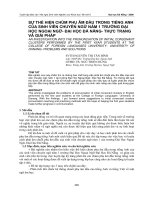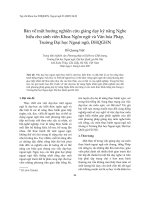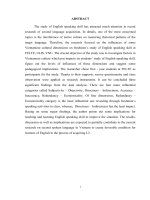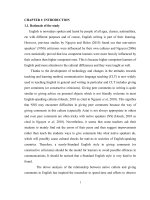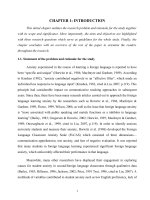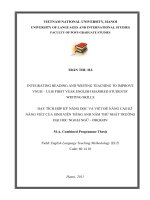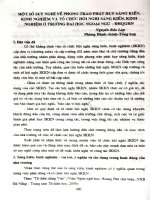Ảnh hưởng của một vài yếu tố văn hóa việt nam đến nhận xét chéo trong môn viết của sinh viên năm nhất trường đại học ngoại ngữ ĐHQGHN
Bạn đang xem bản rút gọn của tài liệu. Xem và tải ngay bản đầy đủ của tài liệu tại đây (677.44 KB, 62 trang )
VIETNAM NATIONAL UNIVERSITY, HANOI
UNIVERSITY OF LANGUAGES AND INTERNATIONAL STUDIES
FACULTY OF ENGLISH LANGUAGE TEACHER EDUCATION
----------
GRADUATION PAPER
THE INFLUENCE OF SOME VIETNAMESE
CULTURAL FACTORS ON PEER COMMENTS
IN WRITING BY FRESHMEN AT ULIS-VNU
Supervisor: Dao Thi Thu Trang, M.A
Student
: Do Tuan Long
Course
: QH2008F1E5
HANOI-2012
1
ACCEPTANCE
I hereby state that I: Do Tuan Long in group 08.1.E5, being a candidate for the
degree of Bachelor of Arts (TEFL) accept the requirements of the College relating to
the retention and use of Bachelors Graduation Paper deposited in the library.
In terms of these conditions, I agree that the origin of my paper deposited in the
library should be accessible for the purposes of study and research, in accordance with
the normal conditions established by the librarian for the care, loan or reproduction of
the paper.
Signature
May 2nd 2012
2
ACKNOWLEDGMENT
I could not complete this graduation paper without very valuable help of many
people who I am deeply indebted to.
Firstly, I would like to send my deepest gratitude to my supervisor, Ms. Dao Thi
Thu Trang, M.A for her enormous help, encouragement and constructive criticisms in
the completion of the thesis.
Furthermore, my sincere thanks also go to Ms. Nguyen Thi Thuy Minh, PhD, who
sent me very precious materials which helped me write the thesis and Mr. Do Tuan
Minh, PhD, who introduced me to my supervisor.
Last but not least, I also would like to thank all lecturers in Division 1, the Faculty
of English Language Teacher Education, ULIS-VNU and students from class 11E2-34-5-19-20 who took interviews and gave comments on essays provided. Without their
help, I could not complete the graduation paper.
Finally, I owe a great debt of gratitude to my family, my friends in group 08.1.E5,
especially P. M. Phuong, 09.1.E2, who always encouraged me to complete my
graduation paper.
3
ABSTRACT
This study was conducted with the participation of 50 freshmen and 10 lecturers
from FELTE, ULIS-VNU. We have tried to find out Vietnamese cultural factors that
have influence on peer comments given by Vietnamese freshmen and their typical
ways of commenting in the 2011 - 2012 academic school-year. It was found that
Vietnamese freshmen used more indirect ways of expressing their attitudes, feeling
rather than direct ones, and this result is the same with many results of other previous
qualitative and quantitative studies. However, it was proven in this case study that if
other researchers showed Vietnamese exploited more positive politeness rather than
negative politeness, this study represented the opposite thing, i.e. negative politeness
was used more often than positive politeness. It was concluded that the influence of
Vietnamese culture could be seen through comments by freshmen. Additionally, the
researcher also found that Vietnamese freshmen used same ways of commenting like
English natives, which signified that they first identified problem(s) and then suggested
hints for improvements. Last but not least, problems, i.e. words choice and sentence
structures that freshmen had when giving comments were also found. Basing on those
problems, the researcher suggested a three-period teaching schedule which lecturers
could use to teach freshmen how to give comments like what English natives actually
did to avoid potential offense.
4
TABLE OF CONTENTS
TABLE OF CONTENTS
PAGE
List of Tables and Figures
viii
List of Abbreviations
ix
Chapter 1: INTRODUCTION
1.1. Rationale of the study
1
1.2. Aims of the study
2
1.3. The research questions
2
1.4. The significance of the study
2
1.5. Scope of the study
3
1.6. Organization of the study
3
Chapter 2: THEORETICAL BACKGROUND
2.1. Language and Culture
5
2.2. Peer comments
8
2.3. Overview of some Anglo-American and Vietnamese Cross-cultural key 9
categorical dimensions
2.3.1. Directness - Indirectness
10
2.3.2. Positive Politeness - Negative Politeness
16
Chapter 03: METHODOLOGY
3.1. Selection of subjects
22
3.2. Research instruments
22
3.3. Procedures of data collection
22
3.4. Procedures of data analysis
23
5
Chapter 04: FINDINGS AND DISCUSSION
4.1. Findings
24
4.1.1. The first research question
24
4.1.2. The second research question
25
4.1.3. The third research question
25
4.1.4. The fourth research question
27
4.2. Discussion
4.2.1. Second culture acquisition in L2 teaching and learning
34
4.2.1.1. The importance of teaching and learning target culture
34
4.2.1.2. The role of teacher in teaching target culture in class
35
4.2.2. Suggested teaching schedule for peer commenting
37
Chapter 05: CONCLUSION
5.1. Summary of the study
39
5.2. Limitations of the study
39
5.3. Suggestions for future research
40
APPENDICES
41
REFERENCES
52
6
LIST OF TABLES, FIGURES
Figure 1: Culture and Nature
Figure 2: Levine and Adelma‟s iceberg of culture
Figure 3: UNESCO‟s definition of culture
Figure 4: Kaplan “cultural thought patterns”
Figure 5: An indirect pattern in communication
Figure 6: A direct pattern in communication
Figure 7: The percentage of direct comments and indirect comments
Figure 8: The percentage of positive politeness and negative politeness
Table 1: Comparing and contrasting Vietnamese freshmen and English natives‟
comments
Table 2: The percentage of each direct and indirect strategy
Table 3: The percentage of some positive politeness strategies
Table 4: The percentage of three negative politeness strategies used by freshmen
7
LIST OF ABBREVIATIONS
CLT:
Communicative Language Teaching
FELTE:
The Faculty of English Language Teacher Education
H(s):
Hearer(s)
IELTS:
International English Language Testing System
L(s):
Learner(s)
NNS(s):
non-native speaker(s)
NS(s):
native speaker(s)
ULIS-VNU: The University of Languages and International Studies, Vietnam
National University, Hanoi
UNESCO:
United Nations Educational, Scientific and Cultural Organization
8
CHAPTER 1: INTRODUCTION
1.1. Rationale of the study
English is nowadays spoken and learnt by people of all ages, classes, nationalities,
etc with different purposes and of course, English writing is part of their learning.
However, previous studies by Nguyen and Helen (2010) found out that non-native
speakers‟ (NNS) criticisms were influenced by their own cultures and Nguyen (2006)
even statistically proved that less competent learners were more heavily influenced by
their cultures than higher competent ones. This is because higher competent learners of
English paid more attention to the cultural differences and they were taught as well.
Thanks to the development of technology and changes in the attitudes towards
teaching and learning method, communicative language teaching (CLT) is now widely
used in teaching English in general and writing in particular and CLT includes giving
peer comments (or constructive criticisms). Giving peer comments in writing is quite
similar to giving advice on personal objects which is not friendly welcome in most
English-speaking cultures (Houck, 2010 as cited in Nguyen et al, 2010). This signifies
that NNS may encounter difficulties in giving peer comments because the way of
giving comments in this culture (especially Asia) is not always appropriate in others
and even peer comments are often tricky with native speakers (NS) (Houck, 2010 as
cited in Nguyen et al, 2010). Nevertheless, it seems that some teachers ask their
students to mainly find out the errors of their peers and then suggest improvements
rather than teach the students ways to give comments like what native speakers do,
which will possibly cause cultural shocks for natives in societies of English-speaking
countries. Therefore, a nearly-Standard English style in giving comments (or
constructive criticisms) should be the model for learners to avoid possible offences in
communications. It should be noticed that a Standard English style is very hard to be
found.
The above analysis of the relationship between native culture and giving
comments in English has inspired the researcher to spend time and efforts to observe
9
the peer comments in writing skill of freshmen at ULIS-VNU. It can be said that
freshmen‟s peer comments are still influenced by native culture and to some extent
peer comments are not appropriate in the English-speaking cultures. In this thesis, the
researcher will discuss the influence of some Vietnamese cultural factors on peer
comments of freshmen and basing on this, the pedagogical implications in teaching
students to give comments will be suggested to help teachers raise their students‟
awareness.
1.2. Aims of the study
The study was undertaken in order to evaluate the influence of Vietnamese culture
on the peer comments of freshmen. The specific objectives of the study are:
- to evaluate the influence of Vietnamese culture on peer comments of freshmen
- to suggest some ways that lecturers can use to help their students deal with this
language transference.
In addition, the aims of the study are also specified in the research questions.
1.3. The research questions
The research questions that the study addressed are:
Research question 1: What are typical ways of giving peer comments of freshmen at
VNU-ULIS?
Research question 2: What are typical ways of giving comments of English native
speakers?
Research question 3: What are similarities and differences of commenting between
freshmen and English native speakers?
Research question 4: What are the Vietnamese cultural factors which have influence
on peer comments of freshmen at VNU-ULIS?
1.4. Significance of the study
The significance of the study is evaluated by its practicality because the study
contributes partial help for both lecturers and students at Division 1, the FELTE, ULISVNU.
10
As for students, they may adapt their ways of giving comments on their peers‟
assignments, which helps their comments sound more polite, avoid potential offence
and encourage their peers to better their assignments. In addition, after graduating from
university, if students have the chance to work with English native speakers, the
suggested ways of giving comments may be useful for them in their working
environment.
As for lecturers, they may reconsider the degree of the influence of some
Vietnamese cultural factors on peer comments of their students. The researcher hopes
that the lecturers will pay attention to teach their students to give comments like what
native speakers actually do in writing. In fact, freshmen are not taught the detailed way
to give comments with appropriate choice of words and expressions, which may make
their comments less effective.
1.5. Scope of the study
Due to limitation of time, knowledge and materials, the researcher only focused on
some Vietnamese cultural factors having influence on peer comments by freshmen and
suggesting some ways to help lecturers deal with this negative language transfer. The
researcher will analyze comments by freshmen on their peers‟ essays and exploit
interviews with both students and lecturers.
1.6. Organization of the study
As can be seen, apart from chapter 1 which gives readers an overview of the study,
there are four other main parts.
Chapter 2 is the theoretical background which reviews some concepts used in the
present study: culture and language and their relation, peer comments and some key
categorical dimensions having influence on freshmen‟s comments.
The methodology exploited will be presented in chapter 3 and information about
subjects, procedure of data collection and analysis will be given clearly as well.
11
Chapter 4 shows findings of the study by answering research questions. Moreover,
the researcher will also discuss the pedagogical implications which can help lecturers
teach their students how to give comments.
The summary and limitation of the study will be shown in chapter 5, the last part of
the study.
12
CHAPTER 2: THEORETICAL BACKGROUND
This chapter sheds light on some background concepts such as “language”,
“culture”, “peer comments” and the relationship between language and culture, and
then some Anglo-American and Vietnamese Cross-cultural key categorical dimensions
that had influence on freshmen‟s comments.
2.1. Language and Culture
“Language” comes from Latin Lingua tongue meaning an utterance or expression,
or a dialect, idioms or mode of speech. As being defined in the Oxford Advanced
Learner‟s Dictionary (2005:862), “language is the system of communication in speech
and writing that is used by people of a particular country or area”. Sharing this point of
view, Crystal (1992:212) suggested that language is the “the systematic, conventional
use of sounds, signs, or written symbols in a human society for communication and
self-expression”. This signifies that language is only used by human beings and this
can serve to distinguish between animals (or any other creatures) and humans.
Culture is derived from Latin “cultura” which means growing or cultivation. It
seems that in the past, most people were farmers and the systems of beliefs and values
were strongly related to farming. Possibly, culture has a close relation with farming (It
can be seen that the word “agriculture” means farming). In fact, it is extremely hard to
say for sure how many definitions of culture there are because each researcher sets
his/her own definition to orient or guide to the target of his/her research. Among these
definitions of culture, Nguyen Quang‟s definition of culture separate between the
“being” and “human” part which associate with “nature” and “culture” respectively.
This can be exemplified as follow:
13
Figure 1: Culture and Nature
However, Levine and Adelman (1993) had different point of view. They supposed
culture was similar to an iceberg, which means that people can only see some visible
parts of culture. This is adopted from their book:
… Culture is like an iceberg, much of the influence of culture on an individual can
hardly be seen but strongly be felt. The visible part of culture does not always create
cross-cultural difficulties. The hidden aspects of culture exercise a strong influence on
behaviour and interactions with others.
14
Culture is illustrated as follow:
Figure 2: Levine and Adelma‟s iceberg of culture
Another definition of culture was given by UNESCO in 1996 which emphasized
that culture involved both the materials and spirituals of human beings. That can be
exemplified as follow:
15
spirituals
materials
Culture
Figure 3: UNESCO‟s definition of culture
In terms of the relationship between language and culture, Kramsch (1983)
supposed that language is “the principle means whereby we conduct our social lives”.
As can be seen, language is now the mirror reflecting the culture. Saville-Troike (1982;
35) also shared this viewpoint in their book titled “The Ethnography of
Communication: An Introduction”: “there is a correlation between the norm and
content of a language and the beliefs, values and needs present in the culture of its
speaker”.
In addition, two terms “language” and “culture” are used interchangeably. When
saying about one culture, people will immediately say about its language and vice
versa. Language was once used to indicate the social status involving culture of the
speaker. In ancient Greece, language was used to distinguish between civilized people
and “barbatos” those who spoke unintelligible languages. Even, in modern England,
dialect (a subcomponent of language) is still used to indicate the social classes of the
speaker.
2.2. Peer comments
First, “peer” is understood as the friend of the same age or the same social status
with a person. “Comment”, according to Oxford Advanced Learner‟s Dictionary
(2005:301), is “something that you say or write which gives an opinion on or explains
16
somebody or something”. Actually, giving peer comments is also considered as part of
the process approach to writing. In this part, a student will give his/her opinion about
his friend‟s writing. One question arisen is whether two terms “peer comments” and
“criticisms” are similar. Criticizing as supposed by Nguyen (2008) is an act of giving
negative evaluation of one‟s work and then stimulating hears/recipients to change. Peer
commenting is often understood by learners of English as evaluating writings of their
peers on the basis of ideas, grammar and word choice.
In the present study, the researcher supposes that giving peer comments is an act of
giving one‟s opinion about one‟s work, i.e. writing of one‟s classmate. It should be
noted that peer commenting is used to influence those who are given comments by first
giving negative (and even positive) evaluation of their work and then suggesting ways
for improvements. Hence, “criticism” and “peer comments” are similar in terms of
giving negative evaluation, a face threatening act. Actually, it will be proved in this
study that giving negative evaluation is the link between “criticism” and “peer
comments”.
2.3. Overview of some Anglo-American and Vietnamese Cross-cultural key
categorical dimensions
Nguyen Quang (1998) supposes that there are fourteen Anglo-American and
Vietnamese Cross-cultural categories as follows:
1. Subjectivity - Objectivity
2. Directness - Indirectness
3. Accuracy - Inaccuracy
4. Positive Politeness - Negative Politeness
5. Self-Abasement - Self-Assertion
6. Abstractness - Rationality
7. Sentimentality - Equality
8. Hierarchy - Equality
9. Introversion - Extroversion
17
10. Deduction - Induction
11. Group Orientation - Individual Orientation
12. High context - Low context
13. Redundancy - Economically
14. Statically - Dynamically
Actually, these categories exist in every language. However, it is not true to say
that one culture only uses this category and refuses the other. There is a preference in
one culture to each category. For example, English native speakers prefer direct style
of speaking whereas Asian people, i.e. Chinese, Vietnamese or Japanese prefer indirect
style.
While giving comments, students will evaluate the work of one‟s of their peers, as
a result, it can be predicted that subjectivity will be used most of the time, which makes
it nonsense to overview Subjectivity-Objectivity.
After analyzing data from subjects of the study, the researcher found that there
were two categories which had influence on peer comments. They are: DirectnessIndirectness and Positive politeness - Negative politeness.
2.3.1. Directness - Indirectness
Kaplan (1972) observed hundreds of essays of students studying in the United
States and concluded that there were differences in expressing ideas among people of
different cultures. He found out what he called “cultural thought patterns” illustrated as
follow:
Figure 4: Kaplan “cultural thought patterns”
As can be seen, in Anglicist direct expressions are preferred and there are some
famous expressions to illustrate this such as “Don‟t go round the bush”, or “Get to the
18
point”. However, Oriental languages prefer indirect style of expressions, which can be
clearly seen in the following letter of refusal.
…Unfortunately, much as I‟d like to be at the wedding, especially a Dutch
wedding (!), it simply isn‟t possible for me to take that weekend off; I have to work
fairly late on Friday night, and friends are coming down to stay from Saturday
lunchtime so there would be no way in which I could squeeze a wedding in Holland in
between…
(As cited from Vu et al, 2006:48)
Do et al (2006) analyzed the following Vietnamese dialogue to prove that
Vietnamese people prefer indirect style in communication. This is taken from their
work.
Let‟s see the dialogue:
- Host: Chả mấy khi bác đến nhà chơi, mời bác ở lại dung bữa với chúng em.
(You rarely come to visit us, we invite you to stay and have dinner with us.)
- Guest: Ô, thôi, cám ơn cô chú. Tôi chỉ ghé thăm cơ chú và gia đình chút thơi.
(Oh, no, thank you. I only pay a short visit to you and your family.)
- Host: Bác cứ nói thế, chả mấy khi…
(You say so, rarely…)
- Guest: Phiền cô chú quá, cứ mỗi lần đến chơi cô chú lại bày vẽ…
(I trouble you, whenever I visit you; you go to unnecessary lengths to …)
(Finally, the guest agreed to stay and have dinner with the host.
refusing
inviting
more inviting
accepting
expressing that
they feel making troubles
Figure 5: An indirect pattern in communication
19
However, an English conversation has different style of expressing. Here is an example.
- Host: Would you like to have more dessert?
- Guest: No, thanks. It‟s delicious but I‟ve really had enough.
- Host: OK. Why don‟t we leave in the table and sit in the living room?
(cited in Do et al)
In this example, it can be seen that the host only offers once and when the guest
refuses for the very first time, he/she no longer asks more but suggests going to the
living room. The pattern of the conversation can be illustrated as follow:
Inviting (Host)
Refusing (Guest)
Going to the living room (Host & Guest)
Figure 6: A direct pattern in communication
In addition, one more thing that needs to be taken into consideration is the location
of information. It can be said that Vietnamese people will give “small talk” first and
then lead to “the main purpose” because of their being indirect but NSs do the opposite,
which can be exemplified as follow:
- In Vietnamese:
Small talk
By the way
Main purpose
- In English
Main purpose
By the way
Small talk
20
However, as in this study the students give written comments on their peer‟s work so
it is essential to judge which evaluation belongs to direct style or indirect style
according to the words used by students. This is adapted from Blum-Kulka (1987:133).
Type
Characteristics
1. Direct comments
Explicitly pointing out the
problem
with
H‟s
Examples
choice/
actions/ work/ products, etc.
a.
Negative Usually
evaluation
evaluative
expressed
via - „„I think it‟s not a good
adjectives
with way to support to one‟s idea
negative meaning or evaluative (L), „„That‟s not really a
adjective
positive good sentence.‟‟ (NS).
with
meaning plus negation
- „„I don‟t like the way you
b. Disapproval
Describing S‟s attitude towards write that (L).
writer‟s choice, etc.
c.
Expression
disagreement
- „„I don‟t quite agree with
of Usually realized by means of you with some points (.)
negation
word
„„No‟‟
or about the conclusion‟‟ (L),
performative „„I don‟t agree‟‟ „„I don‟t really agree with
or „„I disagree‟‟
(with or you as you put it here‟‟
without
or
modal)
via (NS).
arguments against writer.
- „„And there are some
d. Statement of the Stating
problem
errors
or
problems incorrect
found with writer‟s choice, etc.
example
words,
for
„„nowadays‟‟
(L),„„You had a few spelling
mistakes‟‟ (NS).
21
- “I can‟t understand” (L),
e.
Statement
difficulty
of Usually expressed by means of “I
find
it
difficult
to
such structures as “I find it understand your idea” (L)”
difficult to understand…”, “It‟s
difficult to understand…”
- “Someone who doesn‟t
agree
f. Consequences
Warning
about
consequences
or
with
you
would
negative straight away read that and
negative turn off”. (NS)
effects of writer‟s choice, etc
for writer himself or herself or
for the public.
2. Indirect
Implying the problems with
comments
writer‟s choice/ actions/ work/
products, etc by correcting
writer, indicating rules and
standard,
giving
advice,
suggesting or even requesting
and demanding changing to
writer‟s work/ choice and by
means of different kinds of
hints
to
raise
writer‟s
awareness
of
the
inappropriateness of writer‟s
choice.
a. Correction
Including all utterances which -
“safer”
not
“safe”,
have the purposes of fixing comparison (L), and you
errors by asserting specific put “their” I think t-h-e-r-e.
22
alternatives to writer‟s choices,
etc.
b.
Indicating Using stated sentences as a -
standard
collective
obligation
“Theoretically,
a
rather conclusion needs to be some
than an obligation for writer sort of summary”.(L)
personally or as a rule which
commentator thinks commonly
agreed upon and applied to all.
c.
Demand
change
for Usually expressed via such - “You must pay attention to
structures as “you have to”, grammar” (L), “You have
“you must”, “it is obligatory to talk about your opinion
that” or “you are required”, in your summary.” (L)
“you need”, “it‟s necessary
that”, etc.
e.
Advice
change
about Usually
expressed
via
the - “You should change it a
performative “I advise you …” little bit”. (L)
or structures with “should”
with or without modality.
f.
Suggestion
change
for Usually
expressed
via - “I think if you make a full
structures such as “you can”, stop in here, this sentence is
“you could”, “it would be clearer.”
better if”, “why don‟t you?”,
etc.
23
expressing - “I am not sure if you
g. Expressions of Sentences
commentator‟s uncertainty to wrote three paragraphs as
uncertainty
raise writer‟s awareness of the they looked.” (L)
inappropriateness of writer‟s
choice, etc.
h.
Asking/ Rhetorical questions to raise - “Did you read your
presupposing
writer‟s
awareness
of
the writing again after you
inappropriateness of writer‟s finish it?” (L)
choice, etc.
i. Other hints
Including other kinds of hints - “I prefer a writing style
that did not belong to (h) and which is not too personal.”
(i). May include sarcasm.
(L)
2.3.2. Positive politeness - Negative politeness
As written above, after analyzing peer comments by freshmen, the researcher found
that they exploited both positive politeness and negative politeness. In fact, Nguyen
Quang (2005:25) supposed that there were 17 positive politeness strategies and 11
negative politeness strategies used by users of the English language. However, there
were only 3 positive politeness strategies and 3 negative politeness strategies used by
freshmen at ULIS-VNU, which was found by the researcher.
In this part, the researcher will review the theories of both positive politeness and
negative politeness, which will shed light on the analysis of freshmen‟s comments in
the finding section. There will be examples written by freshmen in the strategies
exploited by them.
It is first and foremost to understand what is meant by “politeness”? In terms of
cultural aspect, Yule (1996) defined politeness as ““a fixed concept, as in the idea of
24
„polite social behavior‟, or etiquette, within a culture”. Another definition of
politeness was given by Richards in 1985 which emphasized “the attempt to establish,
maintain, and save face during conversation”. As can be seen politeness is used to
save the face of the H.
2.3.2.1. Positive politeness
According to Brown and Levinson (1990:70), positive politeness “is oriented
toward the positive face of H, the positive self-image that he claims for himself”.
Another way to understand suggested by Nguyen Quang (2005:25) based on “the
concern of the solidarity” is that positive politeness is “any communicative act (verbal
and/ or nonverbal) which is appropriately intended to show the speaker‟s concern to
the addressee, thus, enhancing the sense of solidarity between them”. Here are 15
positive politeness strategies, which are adapted from Nguyen Quang (2004), used by
participants in communication and comments as follow:
Strategy 1: Notice, attend to writer (his interests, wants, needs, goods)
Student‟s comment: I think your essay also has advantages.
Strategy 2: Exaggerate (interest, approval, sympathy with H)
My God! Your work? It‟s absolutely incredible!
Strategy 3: Intensify interest to H ( by (i) „making a good story‟, (ii) involving
switching back and forth between past and present tenses, (iii) using directly quoted
speech rather than indirect reported speech, (iv) using tag question, expressions of
cajolers, appealers or (v) exaggerating facts)
Black I like. I used to wear it more than I do now; I very rarely wear it now. I
wore a black jumper, and when I wear it my Mum says „Ah, she said. But Len likes it,
he thinks it looks ever so nice and quite a few people do. But when my Mum sees it she
said, „Oh, it‟s not your color, you‟re more for pinks and blues.‟
Strategy 4: Use in-group identity markers (usages (i) of address forms, (ii) of language
or dialect, (iii) of jargon or slang, and (iv) of ellipsis.)
Come over here, honey.
25
